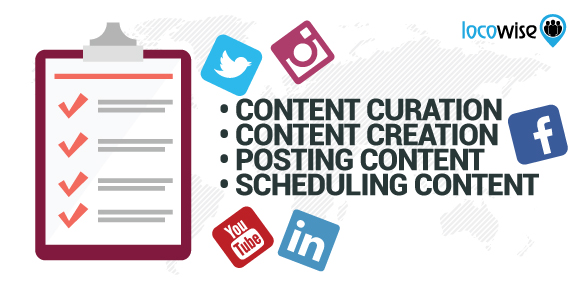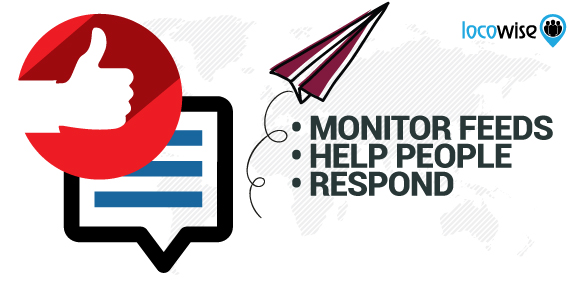How To Master Your Social Media Marketing In Ten Hours Per Week
Sahail Ashraf posted on 3 August 2016
A recent study showed that a large portion of brands don’t have dedicated, full-time social media managers, but run their profiles in 10 hours or less per week.
We like a challenge, and we don’t shy away from the big ones. We thought we would take a look at how you could do all your brand’s social media work in ten hours or less per week.
By the way, we’re not talking a couple of hours per week. We think ten hours is a nice amount. The equivalent of a couple of hours per working day. It should give you enough time to get important things done, and also avoid the mistake of delivering poor engagement.

So how can you manage your social on ten or fewer hours per week? Well, you have to be organised. You need to undertake a certain set of activities on a daily basis and make these activities a habit. The activities generally fit into three key areas.
Content
This is the starting point for your brand when it comes to social media. The content is the stuff that differentiates you and makes your brand stand out. It’s not just about posting content either. It’s also about curating and creating, as well as keeping a general eye out for what is trending and therefore important to share.
To manage the content strand of your two hours a day, it is worthwhile focusing on the following set of actions. Don’t be concerned with sticking to the list below in a rigid fashion, just see it as your guide, and a general list of activities that you should be working on. Some of them will get done every day during your content session, and some won’t. As long as you have the following list as your guide when you are working on social media content, it should help you along.

Content curation
This is where you spend a few minutes checking your feeds, as well as your news feeds and other sources of news and opinion, to find content that you know your audience will be interested in. Get out there for say, ten minutes and find stuff that you would be happy to share with your tribe. Golden rule? It has to be useful.
Content creation
For at least part of your weekly output you should be creating new content. This has to be high quality, stellar content that you know will get your audience engaged. Devote a minimum of fifteen minutes to working on content creation every day and you will have that edge that means you’ll be read and engaged with. This comes because you’ve put time into the process. Alongside content curation comes the creation part. Devote part of every day to it, just a few minutes, and you’ll see that bank of content grow with quality elements as well as the stuff that you find elsewhere.
Posting content
This is the kind of ‘live’ stuff that you want to get out there in the moment. Maybe it’s a news piece that you have stumbled upon, one with a definite shelf life. Or maybe it’s just something fun you’ve found and want to get out there.
Scheduling content
This is everything else. Your bank of content should be growing daily (at least on the curated side) and you should be scheduling so that your content goes out at the right time. Use a good scheduling tool that allows you to focus on the right times to post and you should find even more value. Try the Locowise Publisher.
Engagement
This is the next crucial piece of the puzzle and the second of our three strands. Undertaking activities every day that promote engagement among your followers means that you are constantly feeding your brand message, and building up connections and trust.
You could be spending hours each day creating content that is amazing, but unless you are engaging with the people that matter, there will be no communication, no feedback, no growth for your brand. It’s the difference between ‘speaking to the darkness’ and speaking to a loyal crowd that loves to hear you. Engagement activity needs to be part of your daily routine and your weekly processes on social.

Monitor feeds
Find out what people are saying about you and respond when necessary. This doesn’t always mean bad stuff (although that can be an issue). It can also mean the positive mentions that you know you just have to get in on and comment or just say thank you. Make this a part of your weekly routine, checking to see if people are talking about your brand. If they are, respond. Use Locowise Sentiment Analysis to help you identify posts you should respond to.
Help people
If you see people in your community or groups that have a question or a query or just want some advice, jump in and help. Use this sparingly, perhaps a few minutes every couple of days. Being helpful, though, will ensure that you work to build up that trust that your audience needs.
Respond
If you see comments on your blog, your Facebook and Twitter feeds, this means people are starting to engage with you. Engage back, and build up that conversation. You don’t have to be a tryhard about it. Instead, simply get in on the conversation for a few minutes every time you see that part of your audience is actually talking to you guys directly. It’s a big part of engagement overall.
Measure
After you’ve created content, you’ve started to engage, and everything is going just fine, you need to measure the fruits of your labours. Only through measuring can you save time and money, and aim your resources in the right direction.
Use data
Perhaps this is all we need to say on the measurement thing. Tracking your data carefully allows you to know who you are reaching, and how engagement is growing. It also allows you to make sure that you’re not creating content and engaging in communications that ultimately stop you from making progress. Use your data to see what is happening, what is working, and what isn’t. Locowise is your data friend.
So what next?
Okay, we’ve looked at the three areas you need to be focusing on every day, throughout the week. But you’ve got ten hours or less. Saying is not the same as doing, and we want you to be pretty confident that your daily activity is all making sense.
No more than 15 minutes daily on engagement
You can go overboard on this, but keeping it within the 30-minute mark means you will build in discipline and focus. It will force you to find the engagement opportunities that are worth it.
No more than an hour on content
Content creation and curation and all the rest of that stuff is the biggest chunk of time. If we’re looking at the equivalent of two hours per day in total, you should be spending about an hour curating and creating new stuff. A combination of curation and creation over that hour should mean that bank of content grows. And posting and scheduling content, don’t forget, has to be part of that.
With the final 15 minutes or so, focus on your data and metrics
Primarily, you’re looking for engagement with the content you’re creating. A 10-15 minute session to find out what is working and what isn’t is all you need.
And we reckon that’s about 90 minutes on average every day that you need to spend. You can spend a couple of hours a day of course, but having 90 minutes means you can leave a window of time for those little surprises that come up.
Stay disciplined, and don’t spend too long on any of the three strands. Content is everything, but give the other two strands the time they need too.
Not bad, right? A concrete plan for managing social on less than ten hours per week. It can be done. And as long as you’re checking your metrics, you can make sure you are plotting the right course too.






